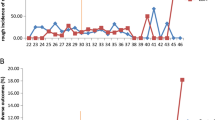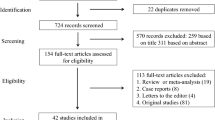Abstract
Objective:
The objective of the study is to evaluate low-dose aspirin (LDA) for pre-eclampsia prevention in twin gestations with elevated maternal serum human chorionic gonadotropin (hCG).
Study Design:
Secondary analysis of the Maternal-Fetal Medicine Units High-Risk Aspirin trial for pre-eclampsia prevention. A threshold hCG level for predicting pre-eclampsia was identified in placebo-randomized patients. Pre-eclampsia incidence and time of onset were compared between treatment groups, overall and by hCG threshold category.
Results:
Pre-eclampsia incidence was lower with LDA than with placebo (6% vs 16%, OR 0.32, 95% CI 0.12 to 0.82). An hCG threshold of 29.96 IU ml−1 best predicted pre-eclampsia. In patients with hCG <29.96 IU ml−1, the differences in pre-eclampsia incidence or time of onset were not significant. In patients with hCG >29.96 IU ml−1, LDA was associated with lower pre-eclampsia incidence than placebo (6% vs 23%, OR 0.21, 95% CI 0.06 to 0.79) and delayed onset.
Conclusion:
Twin gestations with elevated hCG levels may benefit from LDA for pre-eclampsia prevention.
This is a preview of subscription content, access via your institution
Access options
Subscribe to this journal
Receive 12 print issues and online access
$259.00 per year
only $21.58 per issue
Buy this article
- Purchase on Springer Link
- Instant access to full article PDF
Prices may be subject to local taxes which are calculated during checkout




Similar content being viewed by others
References
World Health Organization. The World Health Report 2005: Make Every Mother and Child Count. 2005. Available at http://www.who.int/whr/2005/whr2005_en.pdf (accessed 5 October 2015).
Duley L . The global impact of pre-eclampsia and eclampsia. Semin Perinatol 2009; 33: 130–137.
Askie L, Duley L, Henderson-Smart D, Stewart L, Paris Collaborative Group. Antiplatelet agents for prevention of pre-eclampsia: a meta-analysis of individual patient data. Lancet 2005; 369: 1791–1798.
Coomarasamy A, Honest H, Papaioannou S, Gee H, Khan K . Aspirin for prevention of preeclampsia in women with historical risk factors: a systematic review. Obstet Gynecol 2003; 101: 1319–1332.
Lefevre M, U.S. Preventative Services Task Force. Low-dose aspirin use for the prevention of morbidity and mortality. Ann Intern Med 2014; 161: 819–826.
Bujold E, Roberge S, Lacasse Y, Bureau M, Audibert F, Marcoux S et al. Prevention of preeclampsia and intrauterine growth restriction with aspirin started in early pregnancy. Obstet Gynecol 2010; 116: 402–414.
Henderson J, Whitlock E, O’Connor E, Senger C, Thompson J, Rowland M . Low-dose aspirin for prevention of morbidity and mortality from preeclampsia: a systematic evidence review for the U.S. Preventative Services Task Force. Ann Intern Med 2014; 160: 695–703.
American College of Obstetricians and Gynecologists, Task Force on Hypertension in Pregnancy. Hypertension in pregnancy. Report of the American College of Obstetricians and Gynecologists’ Task Force on Hypertension in Pregnancy. Obstet Gynecol 2013; 122: 1122–1131.
World Health Organization. WHO Recommendations for Prevention and Treatment of Pre-eclampsia and Eclampsia, 2011. Available at http://whqlibdoc.who.int/publications/2011/9789241548335_eng.pdf (accessed 5 October 2015).
Metz T, Allshouse A, Euser A, Heyborne K . Preeclampsia in high risk women is characterized by risk group-specific abnormalities in serum biomarkers. Am J Obstet Gynecol 2014; 211: 512.e1–6.
Olsen R, Woelkers D, Dunsmoor-Su R, LaCoursiere Y . Abnormal second-trimester serum analytes are more predictive of preterm preeclampsia. Am J Obstet Gynecol 2012; 207: 228.e1–7.
Dugoff L, Hobbins JC, Malone FD, Vidaver J, Sullivan L, Canick JA et al. Quad screen as a predictor of adverse pregnancy outcome. Obstet Gynecol 2005; 106: 260–267.
Chandra S, Scott H, Dodds L, Watts C, Blight C, Van den Hof M . Unexplained elevated maternal serum alpha-fetoprotein and/or human chorionic gonadotropin and the risk of adverse outcomes. Am J Obstet Gynecol 2003; 189: 775–781.
Benn PA, Horne D, Briganti S, Rodis JF, Clive JM . Elevated second-trimester maternal serum hCG alone or in combination with elevated alpha-fetoprotein. Obstet Gynecol 1996; 87: 217–222.
Sorenson TK, Williams MA, Zingheim RW, Clement SJ, Hickok DE . Elevated second-trimester human chorionic gonadotropin and subsequent pregnancy-induced hypertension. Am J Obstet Gynecol 1993; 169: 834–838.
Caritis S, Sibai B, Hauth J, Lindheimer MD, Klebanoff M, Thom E et al. Low-dose aspirin to prevent preeclampsia in women at high risk. N Engl J Med 1998; 338: 701–705.
Powers RW, Jeyabalan A, Clifton RG, Dorsten P Van, Hauth JC, Klebanoff MA et al. Soluble fms-Like Tyrosine Kinase 1 (sFlt1), Endoglin and Placental Growth Factor (PlGF) in preeclampsia among high risk pregnancies. PLoS One 2010; 5: e13263.
Sibai B, Romero R, Klebanoff M, Rice MM, Caritis S, Lindheimer MD et al. Maternal plasma concentrations of the soluble tumor necrosis factor receptor 2 are increased prior to the diagnosis of preeclampsia. Am J Obstet Gynecol 2009; 200: e1–630.e8.
Hauth J, Sibai B, Caritis S, Vandorsten P, Klebanoff M, Macpherson C et al. Maternal serum thromboxane B2 concentrations do not predict improved outcomes in high-risk pregnancies in a low-dose aspirin trial. Am J Obstet Gynecol 1998; 179: 1193–1199.
Sibai BM . Prevention of preeclampsia: a big disappointment. Am J Obstet Gynecol 1998; 179: 1275–1278.
Maynard S, Crawford S, Bathgate S, Yan J, Robidoux L, Moore M et al. Gestational angiogenic biomarker patterns in high risk preeclampsia groups. Am J Obstet Gynecol 2013; 209: 53.e1–e9.
Di Lorenzo G, Ceccarello M, Cecotti V, Ronfani L, Monasta L, Vecchi Brumatti L et al. First trimester maternal serum PlGF, free beta-hCG, PAPP-A, PP-13, uterine artery Doppler and maternal history for the prediction of preeclampsia. Placenta 2012; 33: 495–501.
Wenstrom KD, Hauth JC, Goldenberg RL, Dubard MB, Lea C . The effect of low-dose aspirin on pregnancies complicated by elevated human chorionic gonadotropin levels. Am J Obstet Gynecol 1995; 173: 1292–1296.
Acknowledgements
We appreciate the assistance of the National Institute of Child Health and Human Development (NICHD) and the Maternal-Fetal Medicine Units Network in making the database from the MFMU High-Risk Aspirin trial available for secondary analysis. The contents of this report represent the views of the authors and do not represent the views of the Eunice Kennedy Shriver National Institute of Child Health and Human Development Maternal-Fetal Medicine Units Network or the National Institutes of Health.
Author information
Authors and Affiliations
Corresponding author
Ethics declarations
Competing interests
These findings of this study were presented at the 62nd Annual Scientific Meeting of the Society for Reproductive Investigation, 25 to 28 March 2015, in San Francisco, CA.
Rights and permissions
About this article
Cite this article
Euser, A., Metz, T., Allshouse, A. et al. Low-dose aspirin for pre-eclampsia prevention in twins with elevated human chorionic gonadotropin. J Perinatol 36, 601–605 (2016). https://doi.org/10.1038/jp.2016.55
Received:
Revised:
Accepted:
Published:
Issue Date:
DOI: https://doi.org/10.1038/jp.2016.55
This article is cited by
-
Low-dose aspirin for primary prevention of adverse pregnancy outcomes in twin pregnancies: an observational cohort study based on propensity score matching
BMC Pregnancy and Childbirth (2021)
-
Multiple Gestations and Hypertensive Disorders of Pregnancy: What Do We Know?
Current Hypertension Reports (2021)



